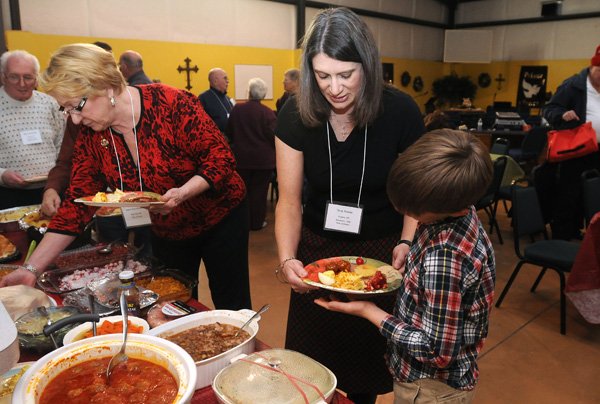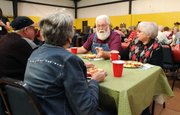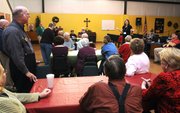Marv Schlesinger has had numerous operations in his 78 years, including triple bypass surgery and a defi brillator implant.
But nothing was as hard to adjust to as the ileostomy performed in 2010, he said.
Doctors removed his diseased colon and created an ostomy, an opening in the stomach that allows waste to pass into a pouch.
“The fact that I had to have a bag hooked to my body didn’t seem right,” Schlesinger said. He became inward and withdrawn, unwilling to leave the house, recalled his wife, Bonnie.
“He was afraid of (the bag) popping off or leaking,” she said.
“I still am,” he interjected, but the fear no longer controls his life. The couple flew to a wedding in Florida in August. They’ve resumed activities they had to stop during Marv’s illness, when he had to use the bathroom as often as 30 times a day.
The two are members of the Northwest Arkansas Ostomy Support Group, a regional network that off ers education and support for those living with ostomies. The people who attend say they have made new friends while learning to adapt to the appliances that are now a constant fact of life.
“Everybody is just so open. We talk about everything,” said Nancy Harris, another member of the group. “People are not hesitant toshow their appliances, in a discreet manner. It is so helpful.” GROUP SUPPORT LESSENS STIGMA
Diana Gallagher, a nurse certified in the care of wounds, ostomies and incontinence, started the group in 2009. An earlier group that operated through Mercy Health System in Rogers had disbanded, she said. The group is an afiliate of the United Ostomy Association of America.
“It’s critically important that people get connected,” Gallagher said. Home health nurses, assigned to help patients adapt in the first days at home, are not specifically trained in ostomy care, she noted. Neither are most healthcare providers patients see in subsequent doctor visits.
“Patients don’t get a lot of education,” she said. “There is so much more to this than simply sticking a pouch on. That’s not always the issue.”
About 35 people attend the monthly meetings, which feature an educational component and a time for networking, Gallagher said. Some drive from as far away as Harrison and Tulsa, Okla.
“It’s an excellent, excellent thing,” said William Nowlin, a colorectal surgeon who attends most meetings. During the Dec. 16 meeting - a Christmas social - he chatted with friends about farming concerns.
“You get here, they’re normal folks. Everyone’s having a good time,” he said.
“You realize you’ve been at some grocery store or gas station, the person in front of you had an ostomy and you didn’t know it. Life is good.”
The primary goal is education, but emotional support also is important, Nowlin said.
“It’s so personal to have an ostomy - so personal you don’t talk about it,” said Whitney Smith, a traveling nurse. Smith had an ileostomy in 2008, but the surgery has since been reversed.
People aren’t bashful about sharing the details of diabetes or heart disease, but ostomies are different, she noted.
“Before you have one, it’s a taboo subject. It’s not a taboo subject (here). We can tell stories of when ‘poop happens.’”
Topics covered in the monthly meetings range from common complications and how to manage them to new developments in the field, Gallagher said. Members learn about traveling with an ostomy, sexual intimacy and emotional changes that might occur.
“It gives you the forethought, before you run into problems, what other people have gone through,” said Anne Hartney of Bentonville, a new member of the group. “They’ve done the trial and error for you.
“It’s not anything you can learn in a hospital setting,” she said. “It’s speaking to somebody who has been through it, that has the best advice.” PATIENTS LEAD ACTIVE LIVES
About half a million people in the United States have ostomies, according to the United Ostomy Association of America. About 65,000 new surgeries are performed each year.
Reasons for having an ostomy include colorectal cancer, bladder cancer, digestive diseases such as ulcerative colitis or Crohn’s disease, trauma and congenital problems, Gallagher said. People at all stages of life can be aff ected.
There are three main types of ostomies - urostomy, which replaces bladder function; colostomy, which replaces part of thecolon; and ileostomy, which replaces the entire colon. Some are temporary and will be reversed.
People with ostomies still lead active lives, Gallagher said. The fears that first arise - people will know, the pouch will bulge under clothing, what if it leaks - are manageable, she said. Many people fi nd that quality of life improves as the medical conditions necessitating ostomy subside.
Tena Reese, president of the support group, had a temporary ostomy in 1990, when she was 21 years old. She’s had a permanent ileostomy since 1998.
The surgery helped relieve the effects of the infl ammatory bowel disease from which she suffers, freeing up more energy for her husband and children, she said. She plays basketball with her sons, 11 and 8, camps andhikes, enjoys water sports such as skiing and inner tubing and takes part in scouting events.
“For me, having an ostomy has meant better health. There are certainly obstacles, but the benefits far outweigh what quality of life would be without it.”
Reese credits her husband, Deron, and her faith for helping with the self-image issues she might have faced.
“The way I handled that was constantly immersing myself in the truth - ‘I am a loved one of God,’” she said.
Rolf Benirschke, former place kicker for the San Diego Chargers, heads Great Comebacks, an awards program that recognizes people who thrive after ostomy surgery.
“It’s just another way of life,” said Irene Boomhower, who helps her husband, Chuck, care for his urostomy. “That’s all it is.”
Life, Pages 6 on 01/09/2013



